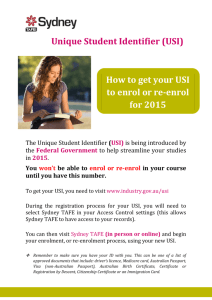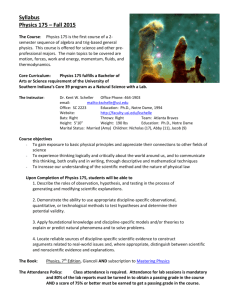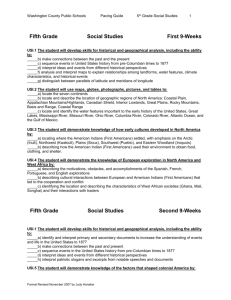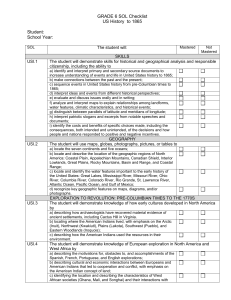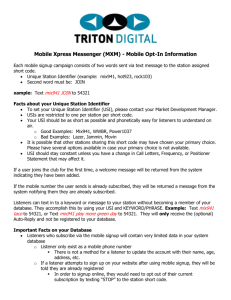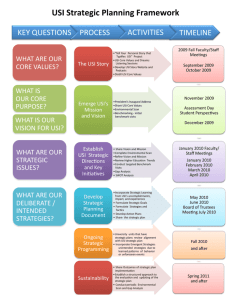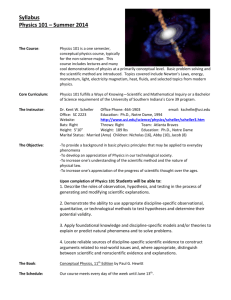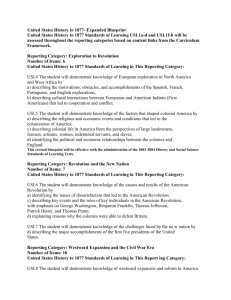Curriculum - Booker T. Washington Elementary School
advertisement
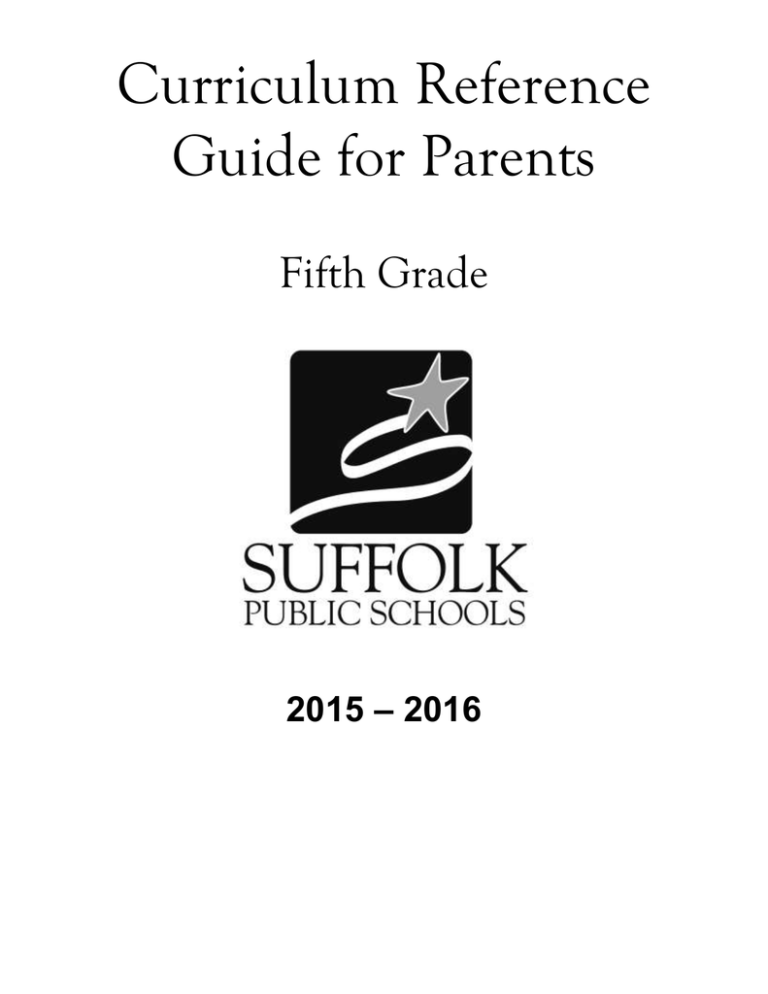
Curriculum Reference Guide for Parents Fifth Grade 2015 – 2016 August 2015 FIFTH GRADE ENGLISH In fifth grade, reading and writing skills continue to support an increased emphasis on content-area learning and utilization of a variety of resources to locate and read primary sources of information. The student will read texts in all subjects and will acquire information to answer questions, generate hypotheses, make inferences, support opinions, confirm predictions, compare and contrast relationships, and formulate conclusions. The student will continue to develop an appreciation for literature by reading a variety of fiction and nonfiction selections. The student will continue to increase communication skills used in learning activities and create a project using online, print, and media resources. The student will use oral and written communication skills to describe key concepts and information contained in the mathematics, science, and history and social science Standards of Learning. In addition, the student will plan, draft, revise, and edit writings to describe, to entertain, to explain, and to persuade. The student will define the meaning and consequences of plagiarism. Communication: Speaking, Listening, Media Literacy 5.1 The student will listen, draw conclusions, and share responses in subject-related group learning activities. a) Participate in and contribute to discussions across content areas. b) Organize information to present in reports of group activities. c) Summarize information gathered in group activities. d) Communicate new ideas to others. e) Demonstrate the ability to collaborate with diverse teams. f) Demonstrate the ability to work independently. 5.2 The student will use effective verbal and nonverbal communication skills to deliver planned oral presentations. a) Maintain eye contact with listeners. b) Use gestures to support, accentuate, and dramatize verbal message. c) Use facial expressions to support and dramatize verbal message. d) Use posture appropriate for communication setting. e) Determine appropriate content for audience. f) Organize content sequentially around major ideas. g) Summarize main points as they relate to main idea or supporting details. h) Incorporate visual media to support the presentation. i) Use language and style appropriate to the audience, topic, and purpose. 5.3 The student will learn how media messages are constructed and for what purposes. a) Differentiate between auditory, visual, and written media messages. b) Identify the characteristics and effectiveness of a variety of media messages. Reading 5.4 The student will expand vocabulary when reading. a) Use context to clarify meaning of unfamiliar words and phrases. b) Use context and sentence structure to determine meanings and differentiate among multiple meanings of words. c) Use knowledge of roots, affixes, synonyms, antonyms, and homophones. d) Identify an author’s use of figurative language. e) Use dictionary, glossary, thesaurus, and other word-reference materials. f) Develop vocabulary by listening to and reading a variety of texts. g) Study word meanings across content areas. 5.5 a) b) c) d) e) f) g) The student will read and demonstrate comprehension of fictional texts, narrative nonfiction, and poetry. Describe the relationship between text and previously read materials. Describe character development. Describe the development of plot and explain the resolution of conflict(s). Describe the characteristics of free verse, rhymed, and patterned poetry. Describe how an author’s choice of vocabulary contributes to the author’s style. Identify and ask questions that clarify various points of view. Identify main idea. h) i) j) k) l) m) Summarize supporting details from text. Draw conclusions and make inferences from text. Identify cause and effect relationships. Make, confirm, or revise predictions. Use reading strategies throughout the reading process to monitor comprehension. Read with fluency and accuracy. 5.6 The student will read and demonstrate comprehension of nonfiction texts. a) Use text organizers, such as type, headings, and graphics, to predict and categorize information in both print and digital texts. b) Use prior knowledge and build additional background knowledge as context for new learning. c) Skim materials to develop a general overview of content and to locate specific information. d) Identify the main idea of nonfiction texts. e) Summarize supporting details in nonfiction texts. f) Identify structural patterns found in nonfiction. g) Locate information to support opinions, predictions, and conclusions. h) Identify cause and effect relationships following transition words signaling the pattern. i) Differentiate between fact and opinion. j) Identify, compare, and contrast relationships. k) Identify new information gained from reading. l) Use reading strategies throughout the reading process to monitor comprehension. m) Read with fluency and accuracy. Writing 5.7 The student will write for a variety of purposes: to describe, to inform, to entertain, to explain, and to persuade. a) Identify intended audience. b) Use a variety of prewriting strategies. c) Organize information to convey a central idea. d) Write a clear topic sentence focusing on the main idea. e) Write multiparagraph compositions. f) Use precise and descriptive vocabulary to create tone and voice. g) Vary sentence structure by using transition words. h) Revise for clarity of content using specific vocabulary and information. i) Include supporting details that elaborate the main idea. 5.8 The student will edit writing for correct grammar, capitalization, spelling, punctuation, sentence structure, and paragraphing. a) Use plural possessives. b) Use adjective and adverb comparisons. c) Identify and use interjections. d) Use apostrophes in contractions and possessives. e) Use quotation marks with dialogue. f) Use commas to indicate interrupters. g) Use a hyphen to divide words at the end of a line. h) Edit for fragments and run-on sentences. i) Eliminate double negatives. j) Use correct spelling of commonly used words. k) Identify and use conjunctions. Research 5.9 The student will find, evaluate, and select appropriate resources for a research product. a) Construct questions about a topic. b) Collect information from multiple resources including online, print, and media. c) Use technology as a tool to research, organize, evaluate, and communicate information. d) Organize information presented on charts, maps, and graphs. e) Develop notes that include important concepts, summaries, and identification of information sources. f) Give credit to sources used in research. g) Define the meaning and consequences of plagiarism. MATH Number and Number Sense Focus: Prime and Composite Numbers and Rounding Decimals 5.1 The student, given a decimal through thousandths, will round to the nearest whole number, tenth, or hundredth. 5.2 The student will a) recognize and name fractions in their equivalent decimal form and vice versa; and b) compare and order fractions and decimals in a given set from least to greatest and greatest to least. 5.3 The student will a) identify and describe the characteristics of prime and composite numbers; and b.) identify and describe the characteristics of even and odd numbers. Computation and Estimation Focus: Multistep Applications and Order of Operations 5.4 The student will create and solve single-step and multistep practical problems involving addition, subtraction, multiplication, and division with and without remainders of whole numbers. 5.5 The student will a) find the sum, difference, product, and quotient of two numbers expressed as decimals through thousandths (divisors with only one nonzero digit); and b) create and solve single-step and multistep practical problems involving decimals. 5.6 The student will solve single-step and multistep practical problems involving addition and subtraction with fractions and mixed numbers and express answers in simplest form. 5.7 The student will evaluate whole number numerical expressions, using the order of operations limited to parentheses, addition, subtraction, multiplication, and division. Measurement Focus: Perimeter, Area, Volume, and Equivalent Measures 5.8 The student will a) find perimeter, area, and volume in standard units of measure; b) differentiate among perimeter, area, and volume and identify whether the application of the concept of perimeter, area, or volume is appropriate for a given situation; c) identify equivalent measurements within the metric system; d) estimate and then measure to solve problems, using U.S. Customary and metric units; and e) choose an appropriate unit of measure for a given situation involving measurement using U.S. Customary and metric units. 5.9 The student will identify and describe the diameter, radius, chord, and circumference of a circle. 5.10 The student will determine an amount of elapsed time in hours and minutes within a 24-hour period. 5.11 The student will measure right, acute, obtuse, and straight angles. Geometry Focus: Classification and Subdividing 5.12 The student will classify a) angles as right, acute, obtuse, or straight; and b) triangles as right, acute, obtuse, equilateral, scalene, or isosceles. 5.13 The student, using plane figures (square, rectangle, triangle, parallelogram, rhombus, and trapezoid), will a) develop definitions of these plane figures; and b) investigate and describe the results of combining and subdividing plane figures. Probability and Statistics Focus: Outcomes and Measures of Center 5.14 The student will make predictions and determine the probability of an outcome by constructing a sample space. 5.15 The student, given a problem situation, will collect, organize, and interpret data in a variety of forms, using stem and stem-and-leaf plots and line graphs. 5.16 The student will a) describe mean, median, and mode as measures of center; b) describe mean as fair share; c) find the mean, median, mode, and range of a set of data; and d) describe the range of a set of data as a measure of variation. Patterns, Functions, & Algebra Focus: Equations and Properties 5.17 The student will describe the relationship found in a number pattern and express the relationship. 5.18 The student will a) investigate and describe the concept of variable; b) write an open sentence to represent a given mathematical relationship, using a variable; c) model one-step linear equations in one variable, using addition and subtraction; and d) create a problem situation based on a given open sentence, using a single variable. 5.19 The student will investigate and recognize the distributive property of multiplication over addition. SCIENCE The fifth-grade standards emphasize the importance of selecting appropriate instruments for measuring and recording observations. The organization, analysis, and application of data continue to be an important focus of classroom inquiry. Science skills from preceding grades, including questioning, using and validating evidence, and systematic experimentation, are reinforced at this level. Students are introduced to more detailed concepts of sound and light and the tools used for studying them. Key concepts of matter, including those about atoms, molecules, elements, and compounds, are studied, and the properties of matter are defined in greater detail. The cellular makeup of organisms and the distinguishing characteristics of groups of organisms are stressed. Students learn about the characteristics of the oceans and Earth’s changing surface. The fifth-grade standards focus on student growth in understanding the nature of science. This scientific view defines the idea that explanations of nature are developed and tested using observation, experimentation, models, evidence, and systematic processes. The nature of science includes the concepts that scientific explanations are based on logical thinking; are subject to rules of evidence; are consistent with observational, inferential, and experimental evidence; are open to rational critique; and are subject to refinement and change with the addition of new scientific evidence. The nature of science includes the concept that science can provide explanations about nature, can predict potential consequences of actions, but cannot be used to answer all questions. Scientific Investigation, Reasoning, and Logic 5.1 The student will demonstrate an understanding of scientific reasoning, logic, and the nature of science by planning and conducting investigations in which a) items such as rocks, minerals, and organisms are identified using various classification keys; b) estimates are made and accurate measurements of length, mass, volume, and temperature are made in metric units using proper tools; c) estimates are made and accurate measurements of elapsed time are made using proper tools; d) hypotheses are formed from testable questions; e) independent and dependent variables are identified; f) constants in an experimental situation are identified; g) data are collected, recorded, analyzed, and communicated using proper graphical representations and metric measurements; h) predictions are made using patterns from data collected, and simple graphical data are generated; i) inferences are made and conclusions are drawn; j) models are constructed to clarify explanations, demonstrate relationships, and solve needs; and k) current applications are used to reinforce science concepts. Force, Motion, and Energy 5.2 The student will investigate and understand how sound is created and transmitted, and how it is used. Key concepts include a) compression waves; b) vibration, compression, wavelength, frequency, amplitude; c) the ability of different media (solids, liquids, and gases) to transmit sound; and d) uses and applications of sound waves. 5.3 The student will investigate and understand basic characteristics of visible light and how it behaves. Key concepts include a) transverse waves; b) the visible spectrum; c) opaque, transparent, and translucent; d) reflection of light from reflective surfaces; and e) refraction of light through water and prisms. Matter 5.4 The student will investigate and understand that matter is anything that has mass and takes up space; and occurs as a solid, liquid, or gas. Key concepts include a) distinguishing properties of each phase of matter; b) the effect of temperature on the phases of matter; c) atoms and elements; d) molecules and compounds; and e) mixtures including solutions. Living Systems 5.5 The student will investigate and understand that organisms are made of one or more cells and have distinguishing characteristics that play a vital role in the organism’s ability to survive and thrive in its environment. Key concepts include a) basic cell structures and functions; b) classification of organisms using physical characteristics, body structures, and behavior of the organism; and c) traits of organisms that allow them to survive in their environment. Interrelationships in Earth/Space Systems 5.6 The student will investigate and understand characteristics of the ocean environment. Key concepts include a) geological characteristics; b) physical characteristics; and c) ecological characteristics. Earth Patterns, Cycles, and Change 5.7 The student will investigate and understand how Earth’s surface is constantly changing. Key concepts include a) identification of rock types; b) the rock cycle and how transformations between rocks occur; c) Earth history and fossil evidence; d) the basic structure of Earth’s interior; e) changes in Earth’s crust due to plate tectonics; f) weathering, erosion, and deposition; and g) human impact. SOCIAL STUDIES United States History to 1865 Students will use skills of historical and geographical analysis to explore the early history of the United States and understand ideas and events that strengthened the union. The standards for this course relate to the history of the United States from pre-Columbian times until 1877. Students will continue to learn fundamental concepts in civics, economics, and geography as they study United States history in chronological sequence and learn about change and continuity in our history. They also will study documents and speeches that laid the foundation of American ideals and institutions and will examine the everyday life of people at different times in the country’s history through the use of primary and secondary sources. The study of history must emphasize the intellectual skills required for responsible citizenship. Students practice these skills as they extend their understanding of the essential knowledge defined by all of the standards for history and social science. Skills USI.1 a) b) c) d) e) f) g) h) i) The student will demonstrate skills for historical and geographical analysis and responsible citizenship, including the ability to identify and interpret primary and secondary source documents to increase understanding of events and life in United States history to 1865; make connections between the past and the present; sequence events in United States history from pre-Columbian times to 1877; interpret ideas and events from different historical perspectives; evaluate and discuss issues orally and in writing; analyze and interpret maps to explain relationships among landforms, water features, climatic characteristics, and historical events; distinguish between parallels of latitude and meridians of longitude; interpret patriotic slogans and excerpts from notable speeches and documents. identify the costs and benefits of specific choices made, including the consequences, both intended and unintended, of the decisions and how people and nations responded to positive and negative incentives. Geography USI.2 The student will use maps, globes, photographs, pictures, or tables to a) locate the seven continents and five oceans; b) locate and describe the location of the geographic regions of North America: Coastal Plain, Appalachian Mountains, Canadian Shield, Interior Lowlands, Great Plains, Rocky Mountains, Basin and Range, and Coastal Range; c) locate and identify the water features important to the early history of the United States: Great Lakes, Mississippi River, Missouri River, Ohio River, Columbia River, Colorado River, Rio Grande, St. Lawrence River, Atlantic Ocean, Pacific Ocean, and Gulf of Mexico. d) recognize key geographic features on maps, diagrams, and/or photographs. Exploration to Revolution: Pre-Columbian Times to the 1770s USI.3 The student will demonstrate knowledge of how early cultures developed in North America by a) describing how archaeologists have recovered material evidence of ancient settlements, including Cactus Hill in Virginia. b) locating where the American Indians lived, with emphasis on Arctic (Inuit), Northwest (Kwakiutl), Plains (Lakota), Southwest (Pueblo), and Eastern Woodland (Iroquois); c) describing how the American Indians used the resources in their environment to obtain food, clothing, and shelter. USI.4 The student will demonstrate knowledge of European exploration in North America and West Africa by a) describing the motivations, obstacles, and accomplishments of the Spanish, French, Portuguese, and English explorations; b) describing cultural and economic interactions between Europeans and American Indians that led to cooperation and conflict, with emphasis on the American Indian concept of land; c) identifying the location and describing the characteristics of West African societies (Ghana, Mali, and Songhai) and their interactions with traders. USI.5 The student will demonstrate knowledge of the factors that shaped colonial America by a) describing the religious and economic events and conditions that led to the colonization of America; b) describing life in the New England, Mid-Atlantic, and Southern colonies, with emphasis on how people interacted with their environment to produce goods and services, including examples of specialization and interdependence; c) describing colonial life in America from the perspectives of large landowners, farmers, artisans, women, free African Americans, indentured servants, and enslaved African Americans; d) identifying the political and economic relationships between the colonies and Great Britain. Revolution and the New Nation: 1770s to the Early 1800s USI.6 The student will demonstrate knowledge of the causes and results of the American Revolution by a) identifying the issues of dissatisfaction that led to the American Revolution; b) identifying how political ideas shaped the revolutionary movement in America and led to the Declaration of Independence; c) describing key events and the roles of key individuals in the American Revolution, with emphasis on George Washington, Benjamin Franklin, Thomas Jefferson, and Patrick Henry; d) explaining reasons why the colonies were able to defeat Britain. USI.7 a) b) c) The student will demonstrate knowledge of the challenges faced by the new nation by identifying the weaknesses of the government established by the Articles of Confederation; describing the historical development of the Constitution of the United States; describing the major accomplishments of the first five presidents of the United States. Expansion and Reform: 1801 to 1861 USI.8 The student will demonstrate knowledge of westward expansion and reform in America from 1801 to 1861 by a) describing territorial expansion and how it affected the political map of the United States, with emphasis on the Louisiana Purchase, the Lewis and Clark expedition, and the acquisitions of Florida, Texas, Oregon, and California; b) identifying the geographic and economic factors that influenced the westward movement of settlers; c) describing the impact of inventions, including the cotton gin, the reaper, the steamboat, and the steam locomotive, on life in America; d) identifying the main ideas of the abolitionist and suffrage movements. Civil War: 1860s to 1865 USI.9 The student will demonstrate knowledge of the causes, major events, and effects of the Civil War by a) describing the cultural, economic, and constitutional issues that divided the nation; b) explaining how the issues of states’ rights and slavery increased sectional tensions; c) identifying on a map the states that seceded from the Union and those that remained in the Union; d) describing the roles of Abraham Lincoln, Jefferson Davis, Ulysses S. Grant, Robert E. Lee, Thomas “Stonewall” Jackson, and Frederick Douglass in events leading to and during the war; e) using maps to explain critical developments in the war, including major battles; f) describing the effects of war from the perspectives of Union and Confederate soldiers (including black soldiers), women, and enslaved African Americans. VISUAL ARTS The standards for grade five enable students to use their knowledge and skills to synthesize information, thus allowing them to produce and respond to works of art. Emphasis is on communication of personal values and beliefs in art appreciation and production. Study relates to art produced by cultures from Pre-Columbian times to 1877. Students gain fluency in the use and understanding of the elements of art and the principles of design as they relate to artistic expression and communication. Visual Communication and Production 5.1 The student will synthesize information to produce works of art. 5.2 The student will use the primary colors and black and white to mix a variety of hues, tints, and shades to create a work of art. 5.3 The student will use the elements of art: line, shape, form, color, value, texture, and space to express ideas, images, and emotions. 5.4 The student will develop ideas for works of art by conducting research, making preliminary sketches, and constructing models. 5.5 The student will collaborate with others to produce a work of art that characterizes a historical time period. 5.6 The student will defend a position regarding a historical or contemporary issue through the production of a work of art. 5.7 The student will demonstrate an understanding of symbolic meanings by incorporating symbols in a work of art. 5.8 The student will use linear perspective in a work of art. 5.9 The student will emphasize spatial relationships in works of art. 5.10 The student will use art materials experimentally in expressive works of art. 5.11 The student will use a computer to produce a work of art. 5.12 The student will use three-dimensional art media to create a sculpture in the round, high relief, or bas-relief. 5.13 The student will describe the changes that occur in clay during the ceramic process, including plastic, leatherhard, greenware, bisque, and glazeware. 5.14 The student will produce fiber art that reflects the qualities of the fiber art of another age, culture, or country. Cultural Context and Art History 5.15 The student will compare art, architecture, and artifacts of a past culture with that of the present. 5.16 The student will identify the influences of historic events, subject matter, and media in works of art. 5.17 The student will research artists from a variety of cultures and the works of art they have produced. 5.18 The student will identify and discuss how American historical events influenced works of art, with emphases on Westward Expansion and the Civil War. 5.19 The student will research, compare, and contrast the art of two cultures using contemporary technology. Judgment and Criticism 5.20 The student will compare and contrast art from various cultures and periods, including Pre-Columbian, AfricanAmerican, Colonial American, and European using appropriate art vocabulary. 5.21 The student will discuss an artist’s point of view based on evidence perceived in works of art. 5.22 The student will compare and contrast natural and constructed environments. Aesthetics 5.23 The student will discuss how criteria used to value art varies over time within the same culture. 5.24 The student will describe a valued object within the culture of today in terms of aesthetic preferences. 5.25 The student will articulate reasons for establishing preferences among works of art using appropriate art vocabulary. MUSIC Performance and Production 5.1 The student will sing a repertoire of songs in tune with a clear tone quality. a) Demonstrate beginning choral behaviors and skills in group singing. b) Participate in group singing involving two-part or three-part harmony. c) Develop age-appropriate ability in singing skills. 5.2 5.3 a) b) 5.4 a) b) c) 5.5 5.6 a) b) c) The student will notate and perform rhythmic patterns that include sixteenth notes, a dotted eighth followed by a sixteenth note, single eighth notes, eighth rests, paired eighth notes, quarter notes, quarter rests, half notes, half rests, dotted half notes, whole notes, and whole rests, using body percussion, voice, pitched instruments, or non-pitched instruments. The student will notate and perform melodies from the treble staff, using traditional notation. Use voice or instruments. Use computer technology. The student will respond to music with movement. Perform choreographed and non-choreographed movements. Perform dances and games from various cultures, including traditional folk dances. Use body percussion. The student will perform music of increasing difficulty in musical ensembles, using pitched and rhythm instruments. The student will create music through a variety of experiences. Improvise melodies and rhythms of increasing complexity. Create movement to illustrate meter and form. Compose short melodic or rhythmic phrases within specified guidelines. Cultural Context and Music Theory 5.7 The student will identify theme and variations form. 5.8 The student will use music terminology to describe music performances and compositions. 5.9 The student will identify instruments from various music ensembles, including instruments from other cultures, using sight and sound. 5.10 The student will identify the functions of the top and bottom numbers of meter signatures in duple and triple meters. 5.11 The student will place music examples into broad categories of style. a) Use music terminology to compare and contrast a variety of music styles. b) Explore how vocal style contributes to the quality and enjoyment of musical selections. c) Explore and perform a variety of music styles. d) Identify notable characteristics of the music of world cultures. e) Identify a composer and one musical composition from each of four different periods of music history. Judgment and Criticism 5.12 The student will exhibit respect for the contributions of self and others in a music setting. a) Contribute to a group effort of making music. b) Contribute to a group effort of listening to music. c) Participate in music activities that involve sharing, taking turns, and other ways of demonstrating good citizenship. Aesthetics 5.13 The student will compare and contrast the relationships between music and other disciplines. HEALTH Students in grade five distinguish reliable from unreliable health information and resources. Students’ practices and behaviors demonstrate health knowledge and skills. They begin to see the interconnection between body systems. Students critique advertising and various media displays and work with others to improve community health. Knowledge and Skills 5.1 The student will demonstrate the interpersonal skills necessary to build healthy relationships. Key concepts/skills include a) the development of positive social skills; b) the use of refusal and conflict resolution skills; c) effective verbal and nonverbal communication skills. 5.2 The student will demonstrate responsibility for developing personal health habits and practicing the behaviors that promote an active, healthy lifestyle. Key concepts/skills include a) the relationship between health promotion and disease prevention; b) the connection between dietary guidelines and weight management; c) strategies for managing stress; d) the importance of exercise and recreation; e) the effects of personal health habits on cardiovascular fitness; f) the importance of developing and maintaining a positive self-image. 5.3 The student will analyze the risks of dependence and addiction associated with the use of alcohol, tobacco, inhalants, and other drugs on the systems of the body. Key concepts/skills include a) the effects on the integrated functioning of the body systems; b) the effects on academic performance; c) the effects on relationships with family, peers, and other individuals. Information Access and Use 5.4 The student will critically evaluate how print media, broadcast media, and Internet technology influence perceptions of health information, products, and services. Key concepts/skills include a) strategies for validating health information; b) tools for the critical evaluation of advertisements and promotions. Community Health and Wellness 5.5 The student will explain how peers, families, and community groups work together to build a healthy community. Key concepts/skills include a) collaborative support for environmental issues; b) the existence of customs and traditions; c) promotion of the value of community health and wellness; d) examination of community health issues; e) development of community health projects; f) promotion of volunteerism and community service. PHYSICAL EDUCATION Students in fifth grade apply movement principles and concepts to enhance their movement performance, personal fitness, and game strategy and tactics. They develop proficiency in games, dance, and educational gymnastics. Students demonstrate specialized skills alone, with a partner, or in a small group. They access and use resources to improve personal fitness as they exhibit a physically active lifestyle. Students continue to develop responsible personal and social behaviors as they work with others in safe and respectful ways. Skilled Movement 5.1 The student will demonstrate proficiency in movement skills and skill combinations in complex movement activities. a) Perform complex educational gymnastic sequences, including travel, roll, balance, and weight transfer, with smooth transitions and changes of direction, speed, and flow. b) Perform different types of rhythm/dance sequences. Movement Principles and Concepts 5.2 The student will understand and apply movement principles and concepts in complex movement activities. a) Apply movement concepts of body, space, effort, and relationship to movement. b) Apply principles of accuracy, force, and follow-through when projecting objects. c) Identify and demonstrate basic small-group offensive and defensive tactics and strategies (e.g., body fakes, use of speed, change of direction, keeping body low while moving/guarding). d) Identify and apply principles of practice to enhance performance (e.g., form, consistency, repetition). e) Use feedback, including available technology, to improve performance. Personal Fitness 5.3 The student will describe short- and long-term benefits of engaging in regular physical activity. 5.4 The student will use personal fitness assessment data to enhance understanding of physical fitness. a) Identify sources for data collection (e.g., print materials, community resources, heart rate monitors, Internet, pedometers, skinfold calipers). b) Analyze fitness data to describe and improve personal fitness levels (e.g., apply data to own plan for improvement in at least two components of health-related fitness). Responsible Behaviors 5.5 The student will participate in establishing and maintaining a safe environment for learning physical activities. a) Work independently and with others to improve learning during physical activity. b) Display appropriate cooperative and competitive behaviors. Physically Active Lifestyle 5.6 The student will identify and participate regularly in physical activities based on personal abilities and interests (e.g., for improvement through practice, for enjoyment, for social interaction, for personal challenge). COMPUTER/TECHNOLOGY Basic Operations and Concepts C/T 3-5.1 The student will demonstrate knowledge of the nature and operation of technology systems. Discuss common uses of computers in their daily life and the advantages and disadvantages those uses provide. Communicate about basic technology components with appropriate terminology. C/T 3-5.2 The student will demonstrate proficiency in the use of technology. Use skills and procedures needed to operate various technologies such as scanners, digital cameras and handheld computers. Identify basic software applications such as word processing, databases, and spreadsheets. Social and Ethical Issues C/T 3-5.3 The student will demonstrate knowledge of ethical, cultural, and societal issues related to technology. Identify how technology has changed society in areas such as communications, transportation, and the economy. Discuss ethical behaviors when using information and technology. C/T 3-5.4 The student will practice responsible use of technology systems, information, and software. Understand the need for the school division’s acceptable use policy. Discuss the rationale of fair use and copyright regulations. Follow rules for personal safety when using the Internet. C/T 3-5.5 The student will demonstrate knowledge of technologies that support collaboration, personal pursuits, and productivity. Work collaboratively when using technology. Practice and communicate respect for people, equipment, and resources. Understand how technology expands opportunities for learning. Technology Research Tools C/T 3-5.6 The student will use technology to locate, evaluate, and collect information from a variety of sources. Collect information from a variety of sources. Evaluate the accuracy of electronic information sources. Enter data into databases and spreadsheets. Problem-solving and Decision-making Tools C/T 3-5.7 The student will use technology resources for solving problems and making informed decisions. Determine when technology tools are appropriate to solve a problem and make a decision. Select resources to solve problems and make informed decisions. Technology Communication Tools C/T 3-5.8 The student will use a variety of media and formats to communicate information and ideas effectively to multiple audiences. Produce documents demonstrating the ability to edit, reformat, and integrate various software tools. Use technology tools for individual and collaborative writing, communication, and publishing activities. Use telecommunication tools to communicate and share information with others. 5th Grade Pacing at a Glance Nine Week Marking Period English First 5.4 a,b,e 5.5 g,h,i 5.6 c-e,g 5.7a-i 5.8 a,d,j,k 5.9b-e Second 5.4 c,d,g 5.5 b,c,e 5.6 a,f 5.7 a-i 5.8 b,e,g,h Second Ongoing 5.4 a,b,e 5.5 g-i 5.6 c-e,g 5.7a-i 5.8 a,d,j, k 5.9c Third 5.5 f,j,k 5.6 h-j 5.7 a-i 5.8 c,f,i Third Ongoing 5.4a-e,g 5.5 b,c,e,g-i 5.6 a,c-g 5.7a-i 5.8 a,b,d,e,h,j,k 5.9c Fourth 5.9 a,f,g Fourth Ongoing 5.4a-e,g 5.5 b,c,e-k 5.6 a,c-j 5.7a-i 5.8 a-k 5.9b-e Math Science Social Studies 5.1 5.5a-b 5.9 5.15 5.16 a-d 5.17 5.1 d,e,f 4.1 c,d,f,g,h 5.2 5.3 4.7 4.8 USI.1a-i USI.2a-d USI.3a-c USI.4a-c 5.4 5.7 5.11 5.12 a,b 5.13 a,b 5.18 a-d 5.19 5.1 h,l,j 4.1 a,b,f,g,l 5.4 5.5 4.5 4.4 USI.5a-d USI.6a-d 5.1 a-l 4.1 a-l n/a 5.1 a,b,c,g 4.1 c,f,g,k 5.6 5.7 4.9 USI.7a-c USI.8a-d 5.1 a-l 4.1 a-l n/a 4.2 4.3 4.6 USI.9a-f 5.2 a,b 5.3 a,b 5.6 5.8 a-e 5.9 5.10 5.14 n/a Suffolk Public Schools School Board Members Dr. Michael J. Debranski, Chair Enoch C. Copeland, Vice Chair Linda W. Bouchard Dr. Judith Brooks-Buck Phyllis C. Byrum David P. Mitnick Lorraine B. Skeeter Administration Deran R. Whitney, Ed.D. Superintendent Jacqueline C. Chavis Deputy Superintendent Douglas B. Dohey Chief of Operations Pamela L. Connor, Ed.S. Director of Elementary Leadership Suffolk Public Schools 100 N. Main Street Suffolk, Virginia 23434 (757) 925-6750

